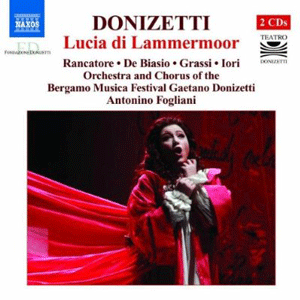Unless…the conductor follows the fashion of adhering to the composer’s original thought and employing a glass harmonica in place of the flute. And that occurs more and more often. Two pieces of evidence here: a 2006 Bergamo Musica Festival production, and perhaps more surprisingly, the 2010 Mariinksy Theater recording. In both cases, the glass harmonica definitely adds to the creepy atmosphere of the scene. The Mariinsky recording offers a sharper aural picture, and the glass harmonicist etches a very clean line of echoing response to soprano Natalie Dessay. The glass harmonica counterpart in the Bergamo recording seems to be caught further from the microphones, slightly dulling the intended effect.
However, in most other respects the Bergamo version scores points over the Mariinsky. Some might have wondered if the starry names associated with the Mariinksy would mean a rival to the opera’s best recorded versions might be appearing. Such is not the case. Conductor Valery Gergiev has a broad symphonic repertoire, but his leadership of Italian opera has received mixed notices. Here, he sustains a poised reading, with no errant tempos or capricious highlighting of stray orchestral detail. Ultimately, however, the reading is a bit dull. More of that Gergiev idiosyncrasy might have helped. The supporting cast is mostly Russian (or at least house singers of the Mariinsky). The heavy tones of Vladislav Sulimsky’s Enrico and Ilya Bannik’s Raimondo blur the characters and veer toward cartoonish villainy.

Gergiev has two superstars as his leads. Lucia is a Natalie Dessay specialty, but this recording almost clinically details the wear and stresses on her instrument from her most recent vocal crisis. The voice is intact, but the suppleness is gone, and high notes fly uncomfortably close to screech territory. Surprisingly, Piotr Bezcala also seems to be in less than ideal voice, with his long final scene occasionally rushed and forced. Both have behind them many finer performances in these roles.
The recordings coming from the Mariinksy label benefit from handsome art design and traditionally generous booklets.
The Naxos, on the other hand, has a thin booklet and nothing else (this is the audio version of a performance also available from Naxos on DVD). The live production was nothing special to look at, and the audio version allows listeners to focus on what an idiomatic conductor and orchestra can provide, as well as the less starry but very capable cast.
Luca Grassi as Enrico and Enrico Giuseppe Iori as Raimondo both possess the right sound for their roles. As Edgardo, the Naxos offers Roberto De Blasio, a rising tenor who has started to pick up a few Metropolitan Opera assignments in the last season. He has just the right weight for the role - masculine, yet limber. In the years since this 2006 recording, he has hopefully brought some more distinctive coloring to his singing. In the title role, Désirée Rancatore puts on a high note display, with crisp coloratura. The middle voice, however, sags under a loose vibrato. Dessay may sound exhausted in her mad scene (not inappropriate), but Rancatore exhausts her listeners in hers, with more of an assault on the scene than an interpretation.
If neither of these versions comes anywhere close the best of the many available recordings of Lucia, the Naxos still deserves the edge for its fluency and old-fashioned commitment.
Chris Mullins

